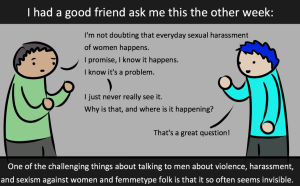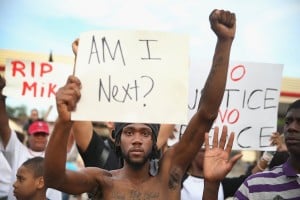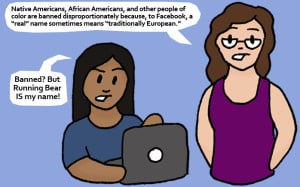
Source: Tumblr
(Content warning: transmisogynistic slurs)
Despite what we like to think, feminism is not always the inclusive space that we want it to be. It can actually be an unsafe place for those seen as outsiders.
While transgender people deserve a central role in the feminist movement, they have been viewed by a small (but vocal!) minority as antithetical to the movement’s goals, purposefully excluding – historically and currently – trans struggles from feminism.
Throughout the second wave in the 1970s and continuing today, trans and gender non-conforming people have experienced exclusion, hate speech, threats, and harassment at the hands of the feminist movement.
For example, Germaine Greer, a feminist voice in the 1970s and well known for her books on sexuality and gender, writes now about trans women being “ghastly parodies” of women, saying that “other delusions may be challenged, but not a man’s delusions that he is female.” (She was glitter-bombed last year by queer activists for her continued transphobic comments.)
Another more hateful so-called feminist is Janice Raymond, who argues in her book The Transsexual Empire: The Making of the He-She that “all transsexuals rape women’s bodies by reducing the real female form to an artifact, appropriating the body for themselves.”
Others include Mary Daly, Sheila Jeffreys, and Julie Bindel – all prominent feminist voices who use feminism as a vehicle to harass trans people as they argue that their very existence does not line up with feminist ideology.
It is truly tragic that some of the most hateful speech against transgender people has come from within feminist movement.
This continues today in the form of Twitter wars, in the physical exclusion of trans women from women-only spaces, and in the theory behind a branch of feminism known as Radical Feminism.
While transphobic feminists are a minority, they have been able to be heard and manufacture power, often teaming up with right-wing Conservatives in affecting policy, and contributing to the culture of violence and harassment against trans people.
Their arguments range from the belief that male-assigned people identify as women “in order to rape women” and “to co-opt and infiltrate women’s spaces,” to the concept that female-assigned people identify as men in order to “escape sexism and attain male privilege.”
There are speeches, websites, and entire books devoted to dehumanizing, outing, and shaming trans people from a supposedly feminist perspective. This behavior is not only hurtful to the trans community, it is destructive to the feminist movement.
Transgender people face institutional discrimination, oppression, and violence as a result of transphobia as well as sexism – due to a structural obsession with the gender binary, with a cultural and political policing of gender roles, and an overall devaluation of feminine qualities.
Trans issues are feminist issues – and if we are to build an intersectional and effective feminist movement, it is imperative that we work to make feminism trans-inclusive.
Trans Exclusion
A common form of transphobia seen within the feminist movement is the exclusion of trans women from women-only spaces.
Trans women are often excluded from domestic violence shelters, women’s homeless shelters, and other supportive women’s spaces, leaving trans women to battle abuse, homeslessness, and misogyny in men’s shelters, abusive homes, and in the streets. Trans women are also excluded from many women’s colleges.
Trans women have and continue to be excluded from women-only feminist spaces.
The most well-known is the Michigan Womyn’s Music Festival, a women-only music festival which arose in the 1970s as a safe-haven for women to share music and serve as a space for political consciousness-raising and empowerment.
But after kicking out a trans woman from the festival in 1991, the festival has stood by an exclusionary policy towards trans women. Many artists and festival-goers have spoken out against this, boycotting and petitioning the festival, yet the festival organizers continue each year to stand by their policy.
What their exclusionary argument comes down to is really an understanding of what women-only space means, that is, that women-only space means cis-women-only.
Women-Only Spaces
Women-only spaces can be empowering and important in creating spaces where women feel safe – so long as it commits to including all women, in particular those marginalized by class status, race, ability, sexuality, and trans status.
Because trans women are women, they should be included in women-only spaces. And yet somehow the concept of women-only spaces has been used to exclude trans women from these intentional safe spaces.
The Michigan Womyn’s Music Festival justifies their intentional trans exclusion by arguing that growing up as a cis woman is “a unique perspective that trans women could not ever understand.” Because trans women do not have this experience, they argue, they have no place in women-only space.
This argument is insulting to trans and cis women alike.
It assumes a universal women’s experience, some unifying quality that all cis women share.
There is a complete disregard for intersectionality here – insinuating that all women, regardless of socioeconomic class, race, ethnicity and nationality, sexual orientation, ability, and so on have had the same experiences in life, and that that experience is unique and that leads to the creation of a space that is safe.
There is also an assumption here that trans people have not been discriminated against in their own right and have not faced major vulnerabilities and struggles in the process of growing up and coming out as trans.
Trans women have the particular experience of facing both transphobia and misogyny.
And who’s to say that women-only spaces, by being women-only, are inherently safe spaces?
This concept assumes that oppression and interpersonal violence are always perpetuated by men against women.
But white women have historically and continue to violate the safety of women of color, upper class women continue to exploit and benefit from the labor of working-class women, and heterosexist women participate in the discrimination against queer women.
I see the need for spaces that are exclusionary and marked specifically for marginalized groups to discuss particular issues they face, but we should inclusively consider the boundaries of these groups – who is in and who is out?
Those who want women-only spaces to mean cis-women-only have adopted the term “women-born women.”
This term presents a sort of authenticity war, in which the boundaries of womanhood are policed. Real womanhood is thus defined as having been “born that way,” or rather, as having the correlating genitalia.
Under this arbitrary and inaccurate categorization, trans women are disqualified from authenticity of womanhood and thus from feminist/women’s spaces on a whole.
If a cis-women-only spaces needs to exist, then call it that.
But when a women-only space is read as cis-women-only, the groups’ very existence serves to delegitimize trans women’s gender identities and experiences.
The Anti-Trans Analysis
The analysis put forth by some trans-exclusionary radical feminists (or TERFs, as they are often called) tends to fall along the lines of biological determinism, arguing that biology is destiny, that women are born second-class citizens, and that men are the underlying problem of all oppression. They see the solution as ending the gender binary.
They argue that trans people reinforce the gender binary, and thus are a threat to gender equality.
I have always found this argument odd, because it makes no sense to me how trans and gender non-conforming people reinforce the gender binary.
If anything, trans people make it more acceptable to break out of that binary, to subvert gender assignments and socialization, and to create a more fluid understanding of gender.
Gender is as simple as this analysis would claim – it is complex, fluid, and relies on a host of cultural assumptions and characteristics that vary from culture to culture and intersect with other variables and identities.
The problem is not that the gender binary exists, but rather that gender is assigned non-consensually, and that anyone who steps outside of the culturally-defined boundaries are marginalized and experience systemic oppression and violence.
The problem isn’t femininity or masculinity. It is compulsory femininity and masculinity tied to a value system that devalues all things feminine.
Denying the existence of cis privilege, the analyses put forth by TERFs oversimplifies the lived experiences of women in a society that devalues those experiences.
Even if their analyses made sense logically, any theory that supports the subordination of a group of people, that asks us to sacrifice the needs of a marginalized group, must be rejected.
People are more important than theory.
But because these analyses are couched within feminist rhetoric, trans-exclusionary feminism is often given another seat at the table – as just another perspective within feminism.
We have to be careful about noticing when this happens, calling attention to feminist spaces that do this in an attempt to be inclusive.
Inclusivity should never mean including hate speech, and that is precisely what this is.
If transphobia is allowed to exist and pass itself off as feminism, then this is a cause that all feminists must take up as their own.
On Building a Trans-Inclusive Feminist Movement
Despite the title of this article, our struggle should not focus only on making the feminist movement more inclusive – this is about making trans people and other marginalized members of the feminist movement a central part of it.
We can’t just call out transphobic attitudes – we have to allow trans people a non-tokenized voice and space in our movement.
In her book Excluded: Making Feminist and Queer Movements More Inclusive, Julia Serano states, “We all have a mutual goal: to find a support network outside of the hetero male-centric mainstream where we can finally feel empowered and affirmed as women.”
Our goal thus becomes, she notes, building communities that celebrate difference rather than sameness, where everyone is listened to, where everyone is seen as a legitimate object of desire, where gender expressions and presentations are not policed, and where trans women are not viewed as less legitimate than cis women.
We have to recognize trans women as women (and include them in women’s spaces!), recognize trans men as men, and recognize genderqueer and non-binary identifying people as being outside of or in between those categories, defined by their own experiences and expression on the gender spectrum.
We can learn to respect the legitimacy of people’s self-identified gender.
We can open ourselves up to the complexity of gender, going beyond our own limited understanding and lived experiences of it.
We can respect that each person is the authority of their own experiences.
Cis and trans women are allies – a part of the same movement to fight sexism – and we absolutely need an inclusive movement that supports and fights for one another if we are to truly understand and overcome the problems we face today.
[do_widget id=”text-101″]
Laura Kacere is a Contributing Writer for Everyday Feminism. She is a feminist activist and organizer, clinic escort, grad school student, and yoga teacher living and going to school in Chicago. When she isn’t studying or on her mat, she’s usually thinking about zombies, playing music, eating Lebanese food, and wishing she was surrounded by trees. Follow her on Twitter @Feminist_Oryx.
Search our 3000+ articles!
Read our articles about:
Our online racial justice training
Used by hundreds of universities, non-profits, and businesses.
Click to learn more
Most Read Articles
- « Previous
- 1
- …
- 30
- 31
- 32



















